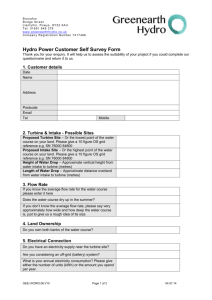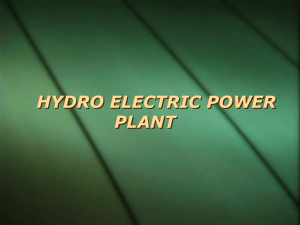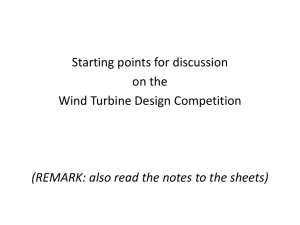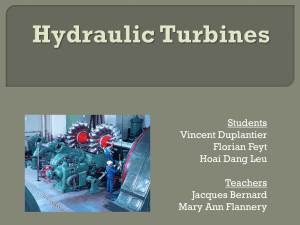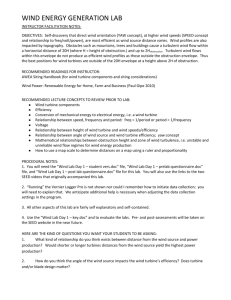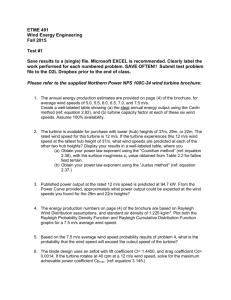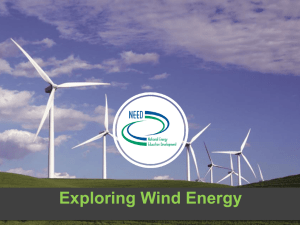PHYS 331 and 580 exam 1
advertisement
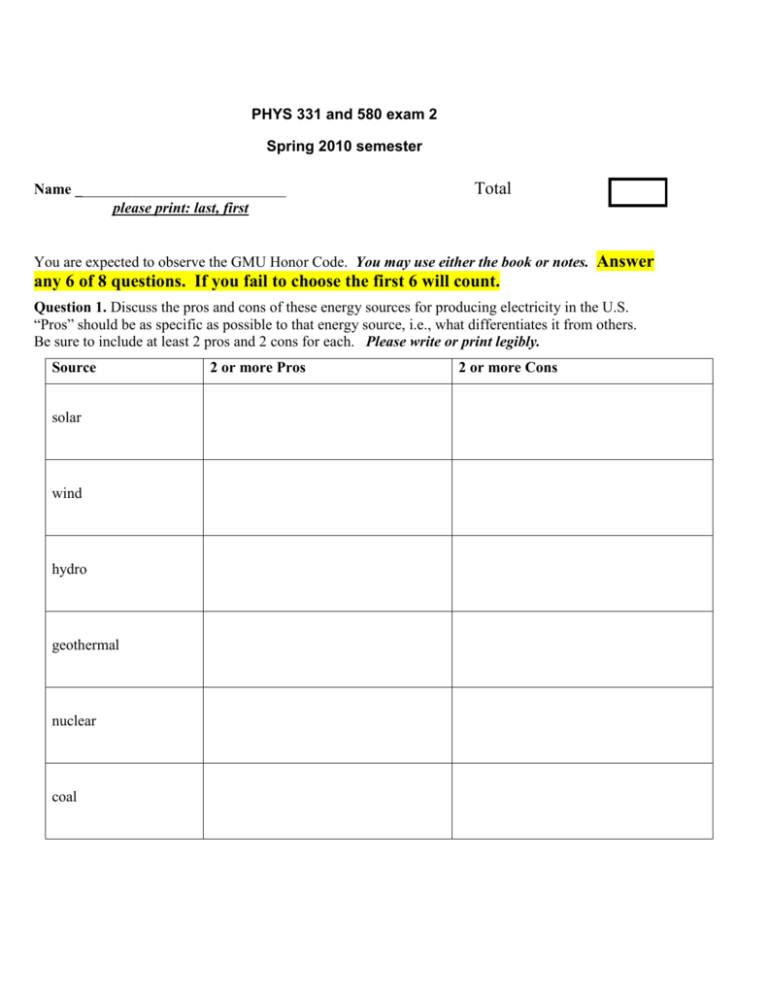
PHYS 331 and 580 exam 2 Spring 2010 semester Name ____________________________ please print: last, first Total You are expected to observe the GMU Honor Code. You may use either the book or notes. Answer any 6 of 8 questions. If you fail to choose the first 6 will count. Question 1. Discuss the pros and cons of these energy sources for producing electricity in the U.S. “Pros” should be as specific as possible to that energy source, i.e., what differentiates it from others. Be sure to include at least 2 pros and 2 cons for each. Please write or print legibly. Source solar wind hydro geothermal nuclear coal 2 or more Pros 2 or more Cons This problem is to be solved by creating an EXCEL spreadsheet, which should be turned in as a printout. Be sure to also turn in a copy of this spread sheet with every equal sign replaced by the three characters “=” (so that I can see exactly what formula was enterd into each cell). Question 2. At a certain location it is found that at a height of 10 m the wind speeds during the year follow a Weibul distribution of the form u Cu e k ( 0.1u ) k Where u is the speed in m/s and the shape parameter k = 2.5. A wind turbine rated at 600 kW has been found to generate these levels of power at the indicated speeds u(m/s) 0 2 4 6 8 10 12 14 16 18 20 22 24 P(kW) 0 0 0 80 220 360 500 550 580 590 600 0 0 Create a spreadsheet so as to find: (a) the constant C so that the distribution is normalized over the interval 0 < u <25 m/s (b) the average wind speed over this range of speeds. (c) the total power the turbine produces at this location averaged over the year. Note that its hub height is 25 m. (d) on a single graph show both the normalized distribution of wind speeds and the fraction of the power produced at each wind speed. Question 3. (a) In nuclear fuel roughly 0.4% of the mass is converted into energy. Use this fact to find the energy density of nuclear fuel in MJ/kg (b) The energy density of gasoline is 129 MJ/gallon. Using typical numbers for the gas milage of a car (25 mi/gal), and the capacity of its tank (15 gal), how how much energy does a car require to travel on a tankful of gas? (This is its “range.”) (c) Suppose we wish to power a car using 12 V lead acid batteries. A car battery with a charge rating of 60 A.h has a mass of 14.5 kg. Based on these data, calculate the energy desity of such batteries in MJ/kg, and using the results from (b) find the mass of batteries that would allow your car to travel as far as you could go on a tank of gas, assuming that the efficiency is the same, i.e., same energy per mile is needed. (d) Aside from further improvements in their energy density, what are two other obstacles to be overcome for electric cars to become a viable option for most car buyers? (e) Among the other renewable alternatives to electric cars that could at some point replace gasolinepowered cars resulting in less CO2 emissions, two of the more promising ones are: ____________________ and _______________________. Question 4. A certain geothermal field used to power a 100 MW plant has a temperature gradient of 500 C/km. The minimum depth for which the rocks are hot enough (T > 175 C) to be useful is 2 km, and the greatest depth that can be drilled is 8 km. Also ssume the rock has a specific heat of 0.84 kJ/kg.K, a thermal conductivity of 2 W/m.K, a density of 3000 kg/m3 , and that the power plant extracts heat over an area of 5 km2 , (a) How much useful thermal energy is contained in this field above the ambient air temperature (300K)? (b) The energy is extracted by pumping water through the rocks. What is the minimum thermal power the rocks need to supply in order to produce an electrical power output of 100 MW, based on the Carnot efficiency? (c) What is the minimum volume flow rate of the water that is needed? (d) If the flow rate of the water is constant over time, how long will it be before the power of the plant becomes half its initial value? Question 5. Parts (b) and (c) of this problem is to be solved by creating an EXCEL spreadsheet, which should be turned in as a printout. Be sure to also turn in a copy of this spread sheet with every equal sign replaced by the three characters “=” (so that I can see exactly what formula was enterd into each cell). Wind turbines cost $500,000 each, have a lifetime of 20 years, and generate 200 kW each on average at a particular location. A farmer puts ten of them on his land without cutting into the acreage dedicated to farming. He sells the electricity back to the power company at $0.10 per kWh, and he pays $25,000 per year to maintain the turbines. (a) What is the payback time for the turbines? (b) Now, using the method of discounted cash flow, create a spreadsheet that will allow you to find the approximate return on investment (ROI) for the farmer. (Hint: the net PV of income at the end of the 20 years should equal the initial layout when the ROI is chosen correctly.) (c) Now suppose that in year 10 due to a severe malfunction one turbine is out of commission entirely. In subsequent years it only produces half its normal power level. Based on these assumptions, develop a new spredsheet that will allow you to find the farmers ROI. Question 6. In a hydropower station the entrance to the penstock (tunnel) that leads water to the turbine lies 10 m below the surface of the reservoir. The control gate to the penstock is fully opened and the penstock has a cross sectional area of 2 m2 . (a) Find the speed at which water enters the penstock, and the flow rate in m3 /s (b) Find the power of the water, nearly all of which is transferred to the turbine (c) Suppose the hydro plant has a Pelton wheel of radius 2 m which is impacted by water coming out of nozzles at a speed of 20 m/s. What is the rotation rate of the wheel for the maximum momentum transfer to it from the water? (Hint: Consider the process in the reference frame moving with the cups on the edge of the wheel.) (d) Give two reasons why hydro plants are more efficient than wind turbines (e) Explain how hydro plants can be used in conjunction with wind turbines so as to cope with both varying loads and wind speeds. Question 7. Consider a pn junction formed by two semiconductors each doped with impurity atoms whose density is 1021 atoms/m3. The size of the band gap is 1.0 eV, and you can assume the temperature T is such that kT = 0.025 eV, for which the density of holes at the Fermi level is 1012 atoms/cm3 (Hint: How are the product of the densities of electrons and holes related?) (a) What is the density of electrons at the Fermi level, EF? (b) What is the density of holes at temperatures for which E = EF + 50kT? (c) What is the density of electrons at temperatures for which E = EF + 50kT? (d) Explain why the resistance of semiconductors decreases as their temperature is raised unlike conductors. (e) In a multijunction solar cell with pn junctions having different band gaps how would you order the layers from the top and why? Question 8. (a) Clearly define the concept of “critical mass” and its applicability to nuclear reactors and weapons. (b) Explain why it is that the heaviest nuclei are the ones that can undergo fission. (c) In a short essay of half a page discuss the assertion that “Nuclear power is ‘green.’”



